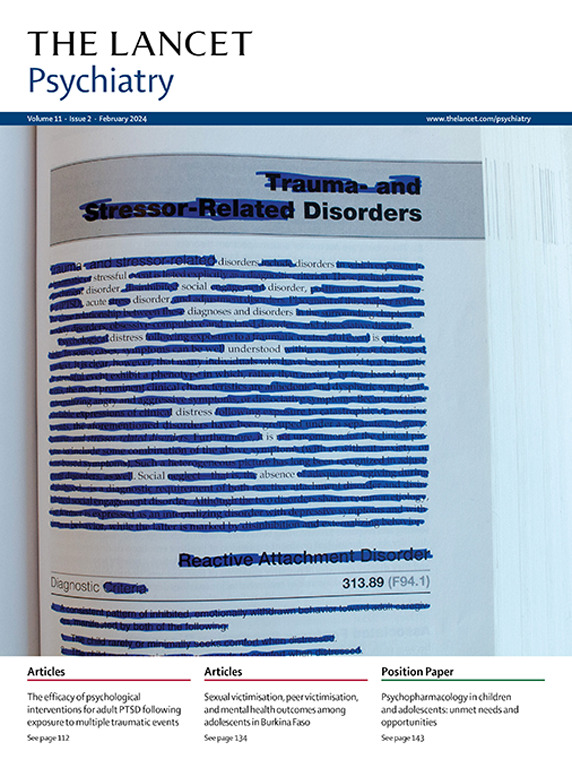青少年内化症状的经济不平等:来自八个国家的纵向证据
IF 30.8
1区 医学
Q1 PSYCHIATRY
引用次数: 0
摘要
背景主要在欧洲和北美进行的研究表明,来自贫困家庭的青少年在内化性心理健康问题上承受着不公平的负担。在这项纵向观察性队列研究中,我们分析了来自全球五个地区八个国家(澳大利亚、埃塞俄比亚、印度、墨西哥、秘鲁、南非、英国和越南)的研究数据。所有研究都使用经过验证的量表对青少年时期两个时间点的内化症状进行了自我报告测量;对家庭收入、家庭消费支出或主观财富进行了测量;并收集了 2000 年至 2019 年期间的数据。家庭收入(在四个国家测量)、消费支出(在六个国家测量)和青少年对家庭财富的主观评估(在五个国家测量)是在青春期中期(14-17 岁)测量的。主要结果(以负面情绪、情感和焦虑为特征的内化症状)是在青春期后期(17 至 19 岁)进行测量的。分析采用调整线性回归模型。研究结果八项研究的总体样本包括18910名青少年(9568名[50-6%]女性和9342名[49-4%]男性)。家庭收入与青少年内化症状的相关性很小或为零。异质性(I2 统计量)为 71-04%,调整基线症状后降至 39-71%。家庭消费支出与内化症状的关系更为密切(随着家庭消费支出增加一倍,秘鲁的下降幅度为 0-075 SD [95% CI -0-136 to -0-013],南非为 0-034 SD [-0-061 to -0-006],越南为 0-141 SD [-0-202 to -0-081])。I2 统计量为 74-24%,调整基线症状后仍为 74-83%。在对青少年主观财富进行测量的五个国家中,有四个国家的青少年主观财富与内化症状相关。I2 统计量为 57-09%,在对基线症状进行调整后(53-25%)保持相似。我们发现有证据表明,在青少年内化症状方面存在经济不平等的跨国差异,其中最突出的是家庭消费支出方面的不平等。我们的研究表明,青少年心理健康方面的经济不平等现象在许多国家都普遍存在,但并非所有国家都是如此,而且因所考虑的经济措施而异。不平等程度的差异表明,国家内部的大环境在这些不平等的形成过程中起着重要作用。本文章由计算机程序翻译,如有差异,请以英文原文为准。
Economic inequalities in adolescents’ internalising symptoms: longitudinal evidence from eight countries
Background
Research, mainly conducted in Europe and North America, has shown an inequitable burden of internalising mental health problems among adolescents from poorer households. We investigated whether these mental health inequalities differ across a diverse range of countries and multiple measures of economic circumstances.Methods
In this longitudinal observational cohort study, we analysed data from studies conducted in eight countries (Australia, Ethiopia, India, Mexico, Peru, South Africa, the UK, and Viet Nam) across five global regions. All studies had self-reported measures of internalising symptoms using a validated scale at two timepoints in adolescence; a measure of household income, household consumption expenditure, or subjective wealth; and data collected between 2000 and 2019. Household income (measured in four countries), consumption expenditure (six countries), and adolescents’ subjective assessment of household wealth (five countries) were measured in mid-adolescence (14–17 years). The primary outcome (internalising symptoms, characterised by negative mood, affect, and anxiety) was measured later in adolescence between age 17 and 19 years. Analyses were linear regression models with adjustment. Effect estimates were added to random-effects meta-analyses to aid understanding of cross-country differences.Findings
The overall pooled sample of eight studies featured 18 910 adolescents (9568 [50·6%] female and 9342 [49·4%] male). Household income had a small or null association with adolescents’ internalising symptoms. Heterogeneity (I2 statistic) was 71·04%, falling to 39·71% after adjusting for baseline symptoms. Household consumption expenditure had a stronger association with internalising symptoms (decreases of 0·075 SD in Peru [95% CI –0·136 to –0·013], 0·034 SD in South Africa [–0·061 to –0·006], and 0·141 SD in Viet Nam [–0·202 to –0·081] as household consumption expenditure doubled). The I2 statistic was 74·24%, remaining similar at 74·83% after adjusting for baseline symptoms. Adolescents’ subjective wealth was associated with internalising symptoms in four of the five countries where it was measured. The I2 statistic was 57·09% and remained similar after adjusting for baseline symptoms (53·25%). We found evidence for cross-country differences in economic inequalities in adolescents’ internalising symptoms, most prominently for inequalities according to household consumption expenditure. Subjective wealth explained greater variance in symptoms compared with the objective measures.Interpretation
Our study suggests that economic inequalities in adolescents’ mental health are prevalent in many but not all countries and vary by the economic measure considered. Variation in the magnitude of inequalities suggests that the wider context within countries plays an important role in the development of these inequalities.Funding
Wellcome Trust.求助全文
通过发布文献求助,成功后即可免费获取论文全文。
去求助
来源期刊

Lancet Psychiatry
PSYCHIATRY-
CiteScore
58.30
自引率
0.90%
发文量
0
期刊介绍:
The Lancet Psychiatry is a globally renowned and trusted resource for groundbreaking research in the field of psychiatry. We specialize in publishing original studies that contribute to transforming and shedding light on important aspects of psychiatric practice. Our comprehensive coverage extends to diverse topics including psychopharmacology, psychotherapy, and psychosocial approaches that address psychiatric disorders throughout the lifespan. We aim to channel innovative treatments and examine the biological research that forms the foundation of such advancements. Our journal also explores novel service delivery methods and promotes fresh perspectives on mental illness, emphasizing the significant contributions of social psychiatry.
 求助内容:
求助内容: 应助结果提醒方式:
应助结果提醒方式:


